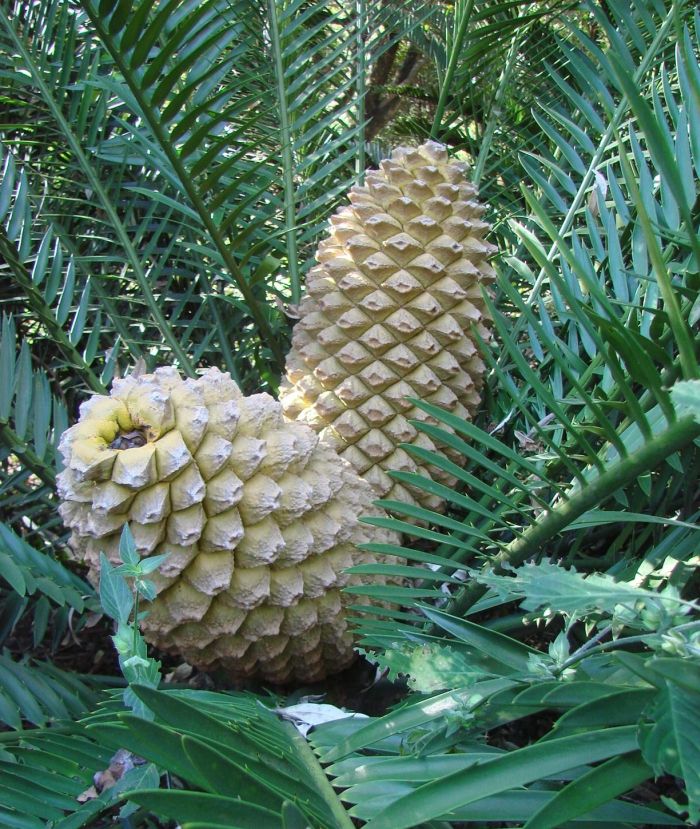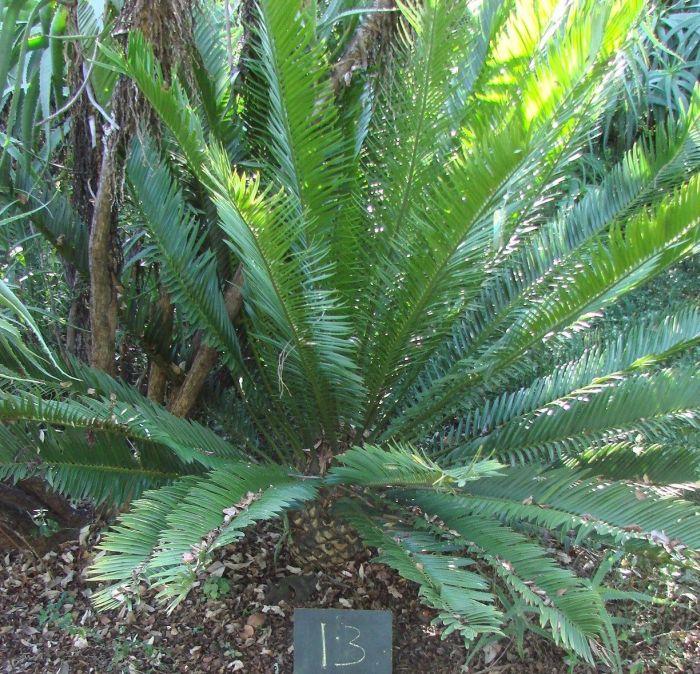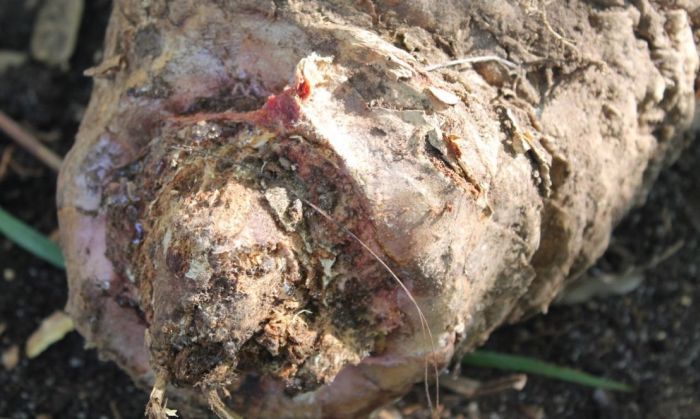Encephalartos msinganus
Encephalartos msinganus Vorster
Family: Zamiaceae
Common names: Msinga cycad (Eng.); msinga-broodboom (Afr.)
SA Tree No: 14.7
Introduction
A medium-sized, glossy green cycad, that occurs in the Msinga area in KwaZulu-Natal; it grows in short grassland on steep north-facing slopes, often suckering from the base to form clumps. This is a rare cycad that is on the brink of extinction in the wild.

Description
Description
Encephalartos msinganus has an aerially unbranched stem, up to 3 m long and 350 mm in diameter. It is erect, but usually leaning to some extent, especially when long, and produces suckers at the base. Much of the stem is covered by the remains of old leaf bases and the crown with dense brown wool. Leaves are medium sized, about 1.1 –1.5 m long, rigid, straight, curved slightly downwards, glossy dark green on the upper side and paler green on the lower side, with prominent longitudinal veins. Leaflets narrow, 16–20 mm wide; they either do not shield one another or do so slightly incubously (when only the upper margins of the leaflets can be seen when a leaf is held horizontally and is viewed from above) at the leaf tip and succubously (when only the lower margins of the leaflet can be seen when a leaf is held horizontally and is viewed from above) in the middle part of the leaf. Basal leaflets are reduced to a few or several spines. Male cones are egg-shaped, 300–400 mm long × 110–120 mm in diameter, pale yellow, hairless, up to 4 per stem, and are produced in midsummer (December), with pollen shedding taking place in autumn (March–April). Female cones are egg-shaped, 420 mm long and 220 mm in diameter. They have a thin, felt-like, brown hairy outer layer that covers and somewhat obscures the cones, which are initially greenish yellow, but turn brighter yellow when mature. The seeds have a bright red fleshy outer layer.

Conservation Status
Status
According to the Red List of South African plants website, this species is assessed as Critically Endangered (CR). It is known from a single, small location and the wild population is declining. There are fewer than 250 plants in the wild and most of the plants occur in one subpopulation. It has been reported that only scattered individuals survive in nature. Plants occur in scattered small clumps along a single ridge. Based on general illegal trade in rare cycads, it is estimated that over 25% of the remaining plants could be removed within the next 30 years. It is at risk from poaching for the ornamental cycad trade, and from habitat destruction in the area.
Distribution and habitat
Distribution description
This cycad occurs in a small area in the Msinga region, near Tugela Ferry in KwaZulu-Natal. It grows in shrub clusters and short grassland, usually amongst rocks in scrub clumps, on steep, north-facing mountain slopes and sandstone cliffs, at elevations of 900–1 200 m above sea level. This area has a number of other cycad species, and it was in this vicinity that, some years ago, a single clump of E. laevifolius was found 300 km from the nearest populations in Swaziland. Other cycads growing near the population of E. msinganus are E. cerinus, E. natalensis and E. villosus.
Derivation of name and historical aspects
History
Encephalartos msinganus was previously referred as the ‘Msinga form’ of E. natalensis, until it was described as a new species in 1996, by Piet J. Vorster. Encephalartos is Greek for ‘bread in head’ and refers to the floury, starchy material in the trunks of some species, which is eaten as famine food by local native tribes. Msinganus refers to the Msinga area of KwaZulu-Natal, where this plant occurs.
In the absence of cones, it is difficult to distinguish this species from E. aemulans, E. lebomboensis, some forms of E. natalensis, and E. senticosus.
In E. aemulans the male and female cones are very similar in size and shape and have a permanent dense, brown, woolly outer layer and the median leaflets are more than 6 times the width.
In E. lebomboensis neither the male nor the female cones are ever woolly and have a smooth surface, in comparison with the cone of E. senticosus, which has a rough outer surface. Leaflets are less than 25 mm wide.
E. natalensis female cones initially have a dense, dark brown to reddish brown woolly coating; male cones are hairless, and leaflets broader than 25 mm, dentate, boat-shaped, with thick margins.
In E. senticosus the cones have a rough outer surface. The female cones initially have a dense dark brown woolly surface layer, which disappear almost completely when mature and the male cones are hairless. Leaflet margins tends to be slightly curved then thickened.
Ecology
Ecology
For a long time it was thought that all cycads were wind pollinated as most coniferous plants are, and the fact that cycads generally produce high volumes of pollen, supported this argument. However, research has shown that insects are the pollinators of cycads. Most cycads are thermogenic (able to produce heat) and emit volatile odours. In nature when the male cone reaches maturity, the central axis elongates and the scales move apart to make room for the release of the pollen, which is transported by insects. The release of pollen usually lasts for 18 days. When the female cone reaches maturity, the cone will heat up, causing it to elongate, and it produces a smell which attracts the insects to the female cone The scales move apart to allow the insects to enter and to pollinate the cone.
Uses
Use
In Zulu culture, most of the cycads are referred to as isqgiki–somkhovu. This name refers to witchcraft practices, where a person is converted into becoming a zombie and is used for witchcraft. The cycad is planted in front of the gate of the homestead to protect it from the evil spirit. If someone practices any witchcraft using umkhovu, this zombie will sit on top of the cycad, which is referred as isqgiki, which means ‘chair’, and that is where the common name is derived from.
This species has become common in private collections, but the ocurrence of the wild species has declined so much, that this species can be considered to be on brink of extinction and its continued existence is uncertain. The decline of this species is partly because it was never abundant, and small cycad populations often experience reproductive failure because of human activities.
Growing Encephalartos msinganus
Grow
This plant grows best in light shade or full sun. This species is frost tolerant and is a fast grower, if it is provided with deep, well-drained soil and is watered frequently.
Encephalartos msinganus is propagated by seed and suckers. Sow seed in river sand and place on a heated bench at 24–28ºC. Germination should start 3 weeks after sowing. However, some seeds will take longer, especially where there is no heat. At the one-leaf stage of development, the seedlings are susceptible to infection by the fungus that causes damping off.
Most cycads produce basal growths, known as pups or suckers. These are small vegetative offsets that are genetically identical to the mother plant. The best time to remove a sucker is in early spring (July-September), during the dormant period.
When a sucker reaches a size of about 80 mm diameter, dig the soil away from around the main cycad to expose the sucker and clean any dirt from the sucker and the main cycad. Use a sharp, clean, cutting tool such as a saw, chisel or knife to cut off the sucker. Make a clean cut at the point of attachment of the sucker to the main plant. As a precaution, especially to valuable species, apply fungicide, Sulphur or a tree seal to the cut area, on both the sucker and the mother plant, to prevent disease and attacks by pests.
If the sucker is large enough (minimum of 250 mm) and it has enough roots, it is best to immediately plant it straight into the ground. Smaller suckers and suckers with no roots of their own must be taken to the nursery, where they should be left to in a cool, dry area to dry for a few weeks to allow the wounds to form a callus.

The next step is to pot the cycad so that it can produce new roots. The sucker must be properly inspected before potting, check the top and bottom of the sucker for any signs of rot. Remove all the leaves. At the base of the sucker, in the root area of the plant, use a sharp knife or chisel to make a sharp cut to expose the meristematic tissue, which is in the area where the new roots will develop. Apply a root stimulant powder at the base of the sucker and in the freshly cut tissue immediately before the tissue dries and seals the wound. Pot the sucker using river sand, for good drainage. The pot should be large enough to accommodate the size of the sucker and give some room for the roots to develop, about 10–15 cm. The time it takes for the cycad to produce roots and new leaves varies between species, but usually takes 6-10months.
For the sucker to develop new roots quickly its must be placed in warm glasshouse, this important because the rooting occurs faster at warmer temperatures. Once the plant has formed roots and a new set of leaves, it can be planted in the ground or into a larger pot. Usually, when the roots come from the base it is a good indication that the plant is ready to be planted into the ground. When moving the cycad into a larger pot, use a deep pot. A recommended potting medium is 50% bark, 50% river sand, bone meal and an organic fertilizer. When a newly transplanted cycad produces cones before leaves, take note that it is a sign that the cycad is stressed and the cone must be removed as soon as possible.
When transplanting cycads with large trunks, cut back about two thirds of the leaves. The remaining leaves can be tied up with a wide strap to facilitate the digging close to the cycad stem. The new hole should be filled with compost-enriched, sandy soil to the desired depth. Make sure that the soil underneath is not clay because this will retain lot of water which can cause the cycad to rot.
References
- Donaldson, J.S. 2009. Encephalartos msinganus Vorster. National Assessment: Red List of South African plants version 2017.1. Accessed on 2019/04/25.
- Goode, D. 1989. Cycads of Africa. Struik Winchester, Cape Town.
- Grobbelaar, N. 2002. Cycads with special reference to the southern African species. Published by the author, Pretoria.
- Ulwazi, sharing indigenous knowledge. Isihlahla sesigqiki somkhovu. https://www.ulwaziprogramme.org/2016/10/isihlahla-sesigqiki-somkhovu/ Accessed on 2019/04/26.
- Vorster, P. 1996. Encephalartos msinganus (Zamiaceae): a new species from KwaZulu-Natal. South African Journal of Botany 62(2): 67–70.
Credits
Lungisani Zondi
Walter Sisulu National Botanical Garden
July 2019
Acknowledgements: images by Willem Froneman, Lowveld NBG.
Plant Attributes:
Plant Type: Shrub, Tree
SA Distribution: KwaZulu-Natal
Soil type: Sandy, Loam
Flowering season:
PH:
Flower colour:
Aspect: Full Sun, Morning Sun (Semi Shade), Afternoon Sun (Semi Shade)
Gardening skill: Average
Special Features:
Horticultural zones









Rate this article
Article well written and informative
Rate this plant
Is this an interesting plant?
Login to add your Comment
Back to topNot registered yet? Click here to register.